Abstract
This study evaluates the performance of tubular solar stills coated with gamma aluminium nanocoatings at concentrations of 5%, 10%, and 15%, compared to a conventional tubular solar still. This is the first experimental study to apply gamma aluminium nanocoatings on tubular solar stills (TSS). The stills were tested for three days, from 9:00 a.m. to 5:00 p.m., under consistent conditions with varying water depths of 1 cm, 2 cm, and 3 cm. The results indicated that the 5% nanocoating achieved the highest water yield, producing 2.571 L/m2 with a 1 cm water depth. The 10% coating produced 2.514 L/m2, while the conventional solar still generated 2.286 L/m2. Thermal efficiency was highest on Day 1 for the 5% concentration, reaching 60.9%, followed by 10% concentration at 59.1%, while the 15% concentration showed the lowest efficiency at 33.8%. In terms of cost-effectiveness, the 5% concentration was the most economical, with the lowest cost per litre (CPL) of USD 0.10 and a payback period of 3.03 months. The 10% concentration had a CPL of USD 0.11 and a payback period of 3.33 months, while the 15% concentration had the highest CPL at USD 0.19 and the longest payback period of 5.63 months. Overall, the 5% concentration offered the best balance of water yield, efficiency, and cost-effectiveness. This research highlights γ-Al2O3 as an innovative, cost-effective material for solar distillation, paving the way for sustainable freshwater production.
1. Introduction
Water shortage is a major global problem, with many areas having inadequate access to potable water. A sustainable alternative is provided by solar desalination, which turns brackish or saltwater into clean, drinkable water by harnessing the sun’s energy. By harnessing solar energy to evaporate and subsequently condense water, leaving salts and contaminants behind, this environmentally benign method replicates the natural water cycle. Solar desalination is an economical and ecologically responsible way to create fresh water by using renewable energy, particularly in regions with plenty of sunshine but little freshwater resources [1,2,3]. Balachandran et al. [4] investigated the use of Fe2O3 nanoparticles in the absorbent layer of a single-sloped solar still, resulting in a higher freshwater yield of 4.39 kg/m2 compared to 3.23 kg/m2 with microparticles due to enhanced thermal conductivity. AE Kabeel et al. [5] investigated the use of CuO nanoparticles in solar still walls, showing a productivity increase of 16–25% over conventional stills and achieving a payback period of 96 days at 10% concentration. Ahmed Mahdi Rheima [6] investigated a photolysis method to synthesise SiO2 nanoparticles (20.7 nm, 3.61 eV band gap) for dye-sensitised solar cells (DSSCs). The nanoparticles improved DSSC efficiency, reaching 2% at 20 mm Rhodamine 6G dye concentration.
Mohammad A. Hamdan et al. [7] investigated the impact of copper and aluminium oxide nanoparticles on water production in solar stills, finding that 0.4% Al2O3 and 0.6% CuO enhanced efficiency by 7.8% and 9.62%, respectively, with CuO consistently yielding more condensate. Murugavel KK et al. [8] studied a basin-type double slope solar still, finding that light black cotton cloth with aluminium fins offers the best performance, aligning closely with theoretical models. Zakaria Omara et al. [9] investigated the modified solar still with an external condenser and a hybrid system that combines wick and corrugated absorbers to purify salinity water. Cuprous and aluminium oxide nanoparticles increase yields by 285.10% and 254.88%, respectively, and this design increases productivity by 180%. S.W. Sharshir [10] investigated the effects of graphite and copper oxide micro-flakes on solar still performance, finding that they enhance productivity by 44.91% and 53.95%, respectively. Using water over the glass cover improves yields by 47.80% and 57.60%. Daily efficiencies reach 38% and 40% without cooling, and 46% and 49% with glass film cooling. R. Mariraja et al. [11] investigated GNP-based nano paint on solar still absorber plates, showing a 48.23% productivity increase over GCNPs and 10.28% over black paint, with 69.77% energy and 22.93% exergy efficiency. Bharti et al. [12] highlight recent advances in using zinc and iron oxide nanomaterials for adsorption and photocatalytic removal of these pollutants from drinking water. Qingliang Luo et al. [13] experimentally studied hierarchical porous carbon nanofibers to enhance solar steam generation with 97.62% light absorption, achieving high efficiency and producing 11.18 kg/m2 of freshwater daily, enough for 4–5 people.
S.W. Sharshir et al. [14] experimentally modified solar stills using flake graphite nanoparticles, phase change material (PCM), and film cooling, improving productivity by 73.8%. Reducing water depth to 0.5 cm further enhanced productivity by 13%, with FGN increasing temperature and vapour pressure. Peyman Zanganeh et al. [15] found that applying nano-silicon coatings to solar stills shifted condensation from filmwise to dropwise, boosting condensate yield by 23% on glass at 50° and increasing dripping on aluminium from 106 mL to 198 mL at 30°. Amrit Kumar Thakur et al. [16] investigated enhancements to solar stills using a 10% rGO-coated absorber and nano-silicon-coated glass, achieving a 3410 mL daily yield with 37% energy and 112% exergy efficiencies, and a water cost of USD 0.01/L. G.N. Tiwari et al. [17] investigated yield enhancements in a passive double slope solar still using Al2O3 nanoparticles in water at 35 kg and 80 kg. With 0.12% Al2O3 concentration, yields increased by 12.2% for 35 kg and 8.4% for 80 kg compared to the base fluid. SW Sharshir et al. [18] investigated three modifications to improve tubular solar still performance: ultrasonic atomizers, cobalt oxide nanoparticles in the wick, and a cooling unit. These enhancements increased freshwater productivity by up to 82.5%, improved thermal efficiency by 68.14%, and reduced freshwater costs by 39.14%. MA Hamada et al. [19] improved the thermal performance of parabolic trough collectors using multiple absorber tube passes, TiO2 nanofluid, and thermal energy storage (graphite). These enhancements increased thermal efficiency by up to 85.4% and maintained high performance throughout the day.
A.E. Kabeel et al. [20] experimentally studied design techniques for tubular solar stills (TSS) to enhance freshwater production. It shows that multi-effect TSS produces more water at costs of USD 0.0061 to USD 0.2 per kg, with horizontal TSS being more efficient than vertical designs. Mahsa Rousta et al. [21] investigated the use of paraffin wax as PCM and nano-enhanced PCM (Co3O4) with aluminium shavings in tubular solar stills, along with baffles coated in micro Al2O3-black paint, achieving productivity increases of up to 24.56% and efficiencies up to 64.3%, while maintaining acceptable TDS levels in distilled water. Abdelkader Saad Abdullah et al. [22] investigated a modified inclined tubular solar still (ITSS) that enhances productivity by tilting the glass cylinder, achieving a 24% increase at a 6° angle. Incorporating Ag nanoparticles and PCM further boosted daily productivity by 62.5% and thermal efficiency to 43.5% compared to the conventional TSS. T Arunkumar et al. [23] investigated the effects of CuO-coated SS316 plates in a solar still, finding that efficiency increased from 37% to 53% and productivity from 2144 mL/m2 to 2995 mL/m2, while adding PVA sponges reduced performance. Kaviti et al. [24] evaluated different absorbers in a solar still, showing combined effect of copper tubes and parabolic fins (2.9 L/m2·day) and cost-efficiency (USD 0.0077/L), outperforming copper tubes and parabolic fins separately. S. Shanmugan et al. [25] examined solar still performance with a TiO2-Cr2O3 nanoparticle-coated copper basin, achieving daily productivity of 5.39 L in winter and 7.89 L in summer, with peak efficiencies of 57.16% in summer and 36.69% in winter. A Behura and HK Gupta [26] found that in a solar still with paraffin wax and CuO nanoparticles, distillate output improved, achieving 440, 455, and 510 mL per 0.25 m2 per day for 0.1%, 0.2%, and 0.3% concentrations, as the NEPCM stabilised temperature and enhanced efficiency.
AE Kabeel et al. [27] investigated a tubular solar still with nano-enhanced phase change material (NPCM), showing a 52% boost in thermal conductivity, leading to a 116.5% increase in efficiency and a cumulative yield of 5.62 kg/m2—higher than conventional setups. P Zanganeh et al. [15] investigated the effect of wettability on solar still efficiency, finding that nano-silicon coating induced dropwise condensation, boosting distillate yield. For instance, condensate production on glass increased by 23% at a 50° angle, while dripping on aluminium rose from 106 mL to 198 mL at 30° after coating. AE Kabeel et al. [28] examined a TiO2 nanoparticle-doped black paint coating on a pyramidal basin solar still, resulting in a 6.1% increase in distilled yield compared to conventional systems. Coated plates achieved 6.6 kg/m2 at 1 cm water depth, enhancing performance during sunshine hours. The authors investigated the impact of silicone nanoparticles on the wettability of condensation surfaces in solar stills to promote dropwise condensation. The results showed that productivity increased from 4828 mL/m2 during film condensation to 5807 mL/m2 under dropwise condensation at a 45° tilt angle [29,30,31].
Despite these advancements, critical gaps remain. Most prior work focuses on stainless steel and copper substrates, whereas gamma aluminium (γ-Al2O3), with its high thermal conductivity, stability, and cost-effectiveness, remains unexplored for solar still applications. Furthermore, the influence of nanoparticle concentration on system efficiency and economic feasibility has not been systematically optimised for tubular solar still (TSS) configurations.
The Novelty of the Current Study
It is observed that solar still efficiency enhancements often focus on improving thermal properties of absorber materials and optimising condensation surfaces through nanocoating. Research highlights that nanoparticles like TiO2 and CuO applied to absorber plates or condensation surfaces can enhance heat transfer, promote dropwise condensation, and increase distillate yield by improving surface wettability and thermal absorption. Commonly used materials, including stainless steel and copper, have been well-studied for solar stills; however, gamma aluminium, to the best of the authors’ knowledge, remains unexplored in this field. Due to its unique thermal conductivity and cost-effectiveness, gamma aluminium holds promise as an efficient alternative for solar distillation. Additionally, the literature suggests that varying nanoparticle concentrations can impact solar still performance, with optimal levels maximising thermal absorption without incurring high costs or compromising efficiency. This study addresses a significant gap by investigating gamma aluminium with nanocoating concentrations of 0%, 5%, 10%, and 15%, under varied water depths and consistent meteorological conditions in October 2024, to identify the most effective material–coating combination. Thermal and economic analyses for each solar still configuration are conducted to provide a comprehensive evaluation of productivity and cost-efficiency, aiming to establish an innovative approach to solar still optimisation. The objectives of the current research are as follows:
- To evaluate the performance of solar stills using gamma aluminium as an absorber material with varying concentrations of nanocoating.
- To analyse the impact of different water depths on the thermal efficiency and distillate yield of the solar stills under consistent meteorological conditions.
- To conduct a comprehensive thermal and economic analysis for each solar still configuration to determine the most effective combination of materials and coatings for maximising productivity and cost-effectiveness in solar distillation applications.
2. Materials and Methodology of Experimentation
This section elaborately discusses the materials used for the fabrication of the solar still, the experimental investigation, and the error analysis conducted throughout the study.
2.1. Material
The material used for nanocoating in this study was gamma aluminium purchased from SRL, Mumbai, India, selected for its excellent thermal conductivity, lightweight properties, and cost-effectiveness, making it an ideal choice for enhancing the performance of solar stills. This material was procured from Hyderabad.
2.2. Nanocoating Preparation
For the preparation of nanoparticle coatings at concentrations of 0%, 5%, 10%, and 15%, the following methods were employed. For the 15% nanoparticle coating, 3 g of gamma alumina was mixed with 30 mL of isopropyl alcohol procured from SRL, Mumbai, India. This mixture was subjected to sonication in an ultrasonic cleaner for 2 h to ensure optimal dispersion. Following sonication, the solution was stirred magnetically for 30 min to achieve uniformity. Afterward, 20 g of black paint were added to the nanoparticle solution, which was then coated onto the thermal absorber plates using a Painter Profit spray gun, purchased from Delhi, India to achieve an even coverage.
For the 10% nanoparticle coating, 2 g of gamma alumina was mixed with 30 mL of isopropyl alcohol, undergoing the same sonication and stirring processes. This solution was also used to coat the corresponding absorber plates.
For the 5% coating, 1 g of gamma alumina was combined with 30 mL of isopropyl alcohol and treated similarly using sonication and stirring before being mixed with black paint for application. The uncoated absorber plates served as the 0% concentration reference. The coated plates were air-dried under ambient conditions for 24 h to ensure complete solvent evaporation and film adhesion. The coating thickness was measured using a precision micrometre at five random locations on each absorber plate, and the mean value was approximately 80–100 µm, ensuring uniform application across all plates. These varied coating concentrations were aimed at assessing their impact on the thermal efficiency and distillate production of the solar stills, enhancing their overall performance through improved heat absorption.
2.3. Experimental Setup
The experimental setup consisted of four identical acrylic solar stills, each with dimensions of 600 mm × 300 mm × 4 mm, as shown in Figure 1. One side of each still was sealed with an acrylic plate, affixed using a combination of Fevicol adhesive and silicone sealant to ensure a watertight bond and prevent leakage. Each still had a 5 mm diameter outlet hole fitted with a pipe for distillate collection. This pipe was directed into graduated measuring vessels to collect and quantify the distilled water when the stills were placed horizontally. Four thermal absorber plates, each with dimensions of 500 mm × 280 mm, were coated with gamma aluminium nanocoatings at concentrations of 0%, 5%, 10%, and 15%. These coated absorber plates were placed inside each solar still to enhance heat absorption based on their respective coating concentrations. Once the absorber plates were inserted, a 2 mm thick polystyrene sheet was used to insulate the remaining open side, minimising heat loss. Each still was equipped with K-type thermocouples positioned on the basin (to measure basin temperature), on the glass cover (to measure glass temperature), and in the water itself. Solar radiation readings were also recorded using a solar power metre, and all temperature data was logged using a key sight data logger for continuous measurement.
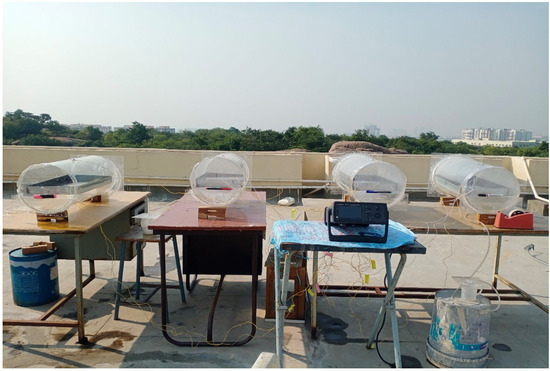
Figure 1.
Experimental setup of four tubular solar stills.
2.4. Experimental Procedure
The experiments were conducted outdoors under consistent meteorological conditions during October 2024. To minimise variability, the tests were scheduled on consecutive clear-sky days from 09:00 a.m. to 05:00 p.m., and solar radiation and ambient temperature were continuously monitored using a calibrated solar power metre and a K-type thermocouple-based data logger, respectively. The stills were positioned identically (horizontal, facing west) and operated simultaneously to ensure uniform exposure to solar flux and wind conditions. No artificial shading or additional thermal sources were introduced. This approach eliminates bias introduced by day-to-day weather variations and ensures that observed differences in performance can be attributed primarily to coating concentrations and water depths rather than uncontrolled environmental fluctuations.
On the first day, each solar still was filled with a controlled amount of 1 cm depth of water. The thermocouples were used to monitor temperature changes at the basin, glass cover, and water surfaces, while solar radiation data was recorded. Distillate collected from each still was funnelled through the outlet pipe and measured using graduated collection vessels. On the second day, the setup was repeated, with the water depth increased to 2 cm to observe the effects of a higher water level on heat absorption and distillate yield. On the third day, water depth was further increased to 3 cm. Temperature and solar radiation measurements were consistently logged throughout each day using a data logger, allowing for a comparative analysis of each solar still’s performance with different gamma aluminium coating concentrations. An uncertainty analysis is added. For instance, temperature measurements via K-type thermocouples have an uncertainty of ±0.5 °C, and solar radiation readings ±5 W/m2. Yield measurements using calibrated graduated cylinders have ±2 mL uncertainty.
2.5. Economic Analysis
The economic analysis revealed that integrating Gamma Aluminium nanocoatings in solar stills improves thermal efficiency while reducing the cost per litre of distilled water. The cost per litre (CPL) and payback period (PP) were calculated using Equations (1) and (2), highlighting the practicality of this approach for enhanced cost-effectiveness.
Cost Per Litre (CPL) = Total Annual Cost/Total Annual Yield
Payback Period (PP) = Initial Investment/Annual profit
3. Results and Discussion
This section presents a detailed analysis of ambient temperature, solar radiation, and water productivity for each type of solar still under study. The findings highlight the environmental parameters and performance variations across different stills, providing insights into their efficiency under varying conditions.
3.1. Solar Radiation and Ambient Temperature
The ambient temperature and solar radiation data for three days are shown in Figure 2. Each day follows a diurnal pattern where temperatures and solar radiation start low at 09:00, peak around midday, and decrease by evening.
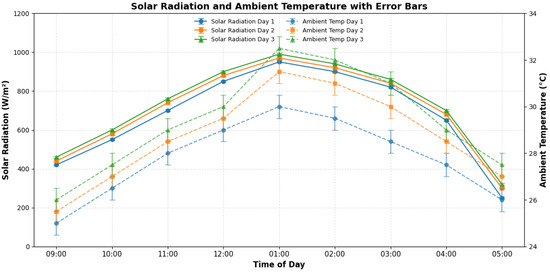
Figure 2.
Variation in solar radiation and ambient temperature.
On Day 1, temperatures begin at 25 °C with solar radiation at 401 W/m2, while Days 2 and 3 start slightly warmer, with temperatures of 27 °C and 28 °C and radiation levels of 420 W/m2 and 440 W/m2, respectively. By 1:00 p.m., each day reaches its peak: Day 1 at 29 °C and 951 W/m2, Day 2 at 32 °C and 970 W/m2, and Day 3 at 33 °C and 990 W/m2. Temperatures and solar radiation then taper off by 5:00 p.m., with Day 1 ending at 26 °C and 239 W/m2, Day 2 at 25.5 °C and 290 W/m2, and Day 3 at 27 °C and 320 W/m2.
The variation in temperature of each solar still at the basin, glass, and water levels was observed over three days using different concentrations of gamma aluminium (0%, 5%, 10%, and 15%) from 09:00 a.m. to 05:00 p.m., as shown in Figure 3, Figure 4 and Figure 5. Each concentration exhibits a similar trend: temperatures rise in the morning, peak around midday, and decrease in the afternoon.
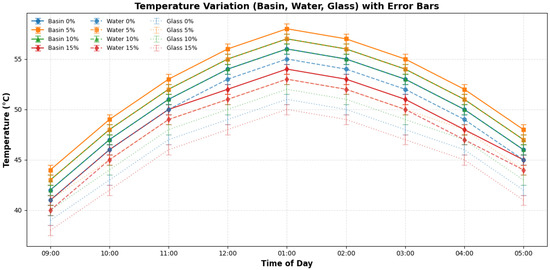
Figure 3.
Variation in temperature of each solar still on Day 1.
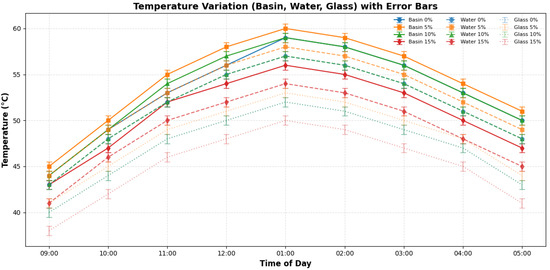
Figure 4.
Variation in temperature of each solar still on Day 2.
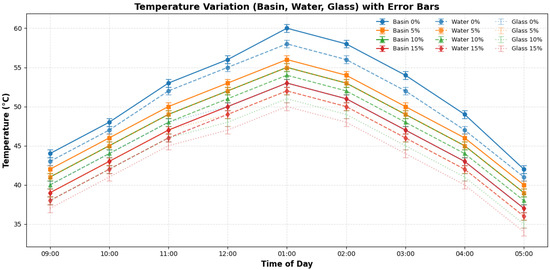
Figure 5.
Variation in temperature of each solar still on Day 3.
At 09:00 a.m., temperatures are relatively low, with the 0% concentration setup recording 41.5 °C in the basin, 40.2 °C in the water, and 39 °C in the glass. The 5% and 10% concentrations show slightly higher initial temperatures. Around midday, the 5% and 10% concentrations demonstrate optimal thermal performance, with the 5% setup reaching 59.2 °C, 55.4 °C, and 52.6 °C, while the 10% setup reaches 59.7 °C, 56 °C, and 53.2 °C. This indicates effective heat absorption and retention at these concentrations, whereas the 15% concentration records slightly lower temperatures, suggesting a saturation effect. In the afternoon, temperatures decline across all setups. By 5:00 p.m., the 0% concentration records 46.1 °C in the basin, while the 15% concentration setup records 45.2 °C in the basin, indicating that higher concentrations still retain more heat.
3.2. Productivity of Solar Stills
The water productivity readings measured in mL/m2 over three days, comparing the effects of different concentrations of gamma aluminium (0%, 5%, 10%, and 15%), are shown in Figure 6. The impact of each concentration on water productivity is evident throughout the day, with varying results based on the concentration used. In the morning, at 09:00 a.m., water productivity is highest at the 10% concentration on Day 1, reaching 92.86 mL/m2, followed closely by the 5% concentration at 85.71 mL/m2. The 0% and 15% concentrations exhibit lower productivity, particularly the 15% concentration at 50 mL/m2. As the day progresses towards midday (12:00 p.m.), water productivity peaks significantly across all concentrations, with the 5% concentration on Day 1 recording the highest value of 385.71 mL/m2. Day 2 shows a similar trend, with the 5% and 10% concentrations yielding substantial productivity at 307.14 mL/m2, indicating that these mid-range concentrations of gamma aluminium effectively enhance water productivity. By the afternoon, productivity starts to decline, but the trend remains consistent across the three days. At 5:00 p.m., the 5% concentration maintains relatively higher productivity, recording 207.14 mL/m2 on Day 1 compared to lower values in the 0% and 15% setups.
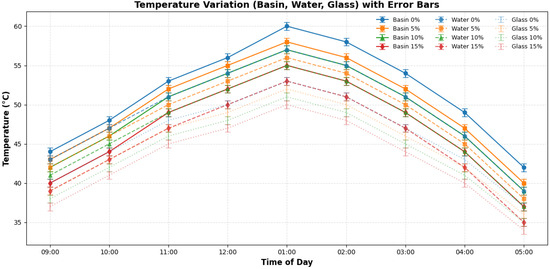
Figure 6.
Instantaneous productivity of each solar still on days 1, 2, and 3.
The cumulative readings, illustrated in Figure 7, further emphasise the effectiveness of 5% and 10% concentrations, showing a clear advantage in water yield throughout the observation period. Overall, the data suggests that water productivity is generally optimised at these mid-range concentrations of gamma aluminium, highlighting their significant role in enhancing water yield as shown in Table 1.
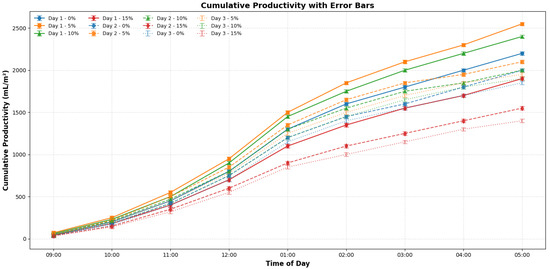
Figure 7.
Cumulative productivity of each solar still on days 1, 2, and 3.

Table 1.
Cumulative Productivity of each solar still.
The 5% and 10% γ-Al2O3 coatings outperformed both the uncoated and 15% configurations in terms of distillate yield and thermal efficiency. Peak basin temperatures for 5% and 10% were 59.2 °C and 59.7 °C, respectively, compared to 41.5 °C for the uncoated still, confirming improved thermal absorption. However, performance declined at 15% concentration (thermal efficiency: 33.8%), consistent with observations on nanoparticle agglomeration found in the literature [15,16]. Agglomeration reduces surface absorptivity and increases optical reflectivity, leading to reduced heat transfer efficiency.
3.3. Economic Analysis
A comprehensive techno-economic analysis was conducted to evaluate the efficacy of solar still systems across several design configurations. The analysis evaluated a system lifespan of 15 years and utilised a uniform interest rate of 10% for all scenarios to guarantee a consistent economic comparison, as shown in Table 2. The economic analysis considered the following cost components: Initial investment: Fabrication of the solar still, cost of coating materials (gamma aluminium nanoparticles, solvents, black paint), and application process. Annualised costs: Maintenance, cleaning, and minor repairs (estimated at 5% of initial cost per year), based on typical solar still operation. The initial net investment fluctuated between USD 53.37 and USD 56.85, while annualised costs varied from USD 7.74 to USD 8.41, contingent upon the precise design. The mean annual freshwater yield exhibited considerable variance, spanning from 428.58 to 771.44 L/m2, with peak productivity recorded at the 5% configuration level. The cost per litre (CPL) of produced water significantly declined with increased production, decreasing from USD 0.19 at the baseline configuration (15%) to USD 0.10 at the 5% configuration. The results indicate that system improvement improves cost-efficiency. The payback period, an essential metric for investment recovery, ranged from 3.03 to 5.63 months, with the lowest duration associated with the configuration producing the maximum water output. The findings demonstrate that moderate design improvements in solar still systems can substantially enhance economic viability and water output, facilitating their widespread implementation in water-scarce areas.

Table 2.
Results of the economic assessment for each solar still.
4. Conclusions
The experiment investigated the performance enhancement of solar stills using varying concentrations of gamma aluminium nanocoatings. Four solar stills were constructed, including three with absorber plates coated at concentrations of 5%, 10%, and 15%, and a fourth uncoated still for comparison. The study assessed the impact of these coatings on distillate yield, temperature variations, and economic efficiency under controlled meteorological conditions. The conclusion from the current study is as follows:
- The gamma aluminium nanocoatings significantly improved solar still performance compared to the conventional uncoated model.
- The highest distillate yields were observed with 5% and 10% coatings, achieving 771.44 mL/m2 and 750.01 mL/m2, respectively.
- Peak basin temperatures reached 59.2 °C for the 5% coating and 59.7 °C for the 10% coating at midday, indicating effective heat absorption.
- The economic analysis showed that the cost per litres (CPL) for the 5% coating was USD 0.10 making it the most cost-effective option.
- The payback period for the 5% coating was the shortest at 3.03 months, indicating a rapid recovery of the initial investment.
- The results indicate that optimising nanocoating concentrations at mid-range levels enhances both thermal efficiency and economic viability in solar distillation applications.
Overall, the study supports the use of gamma aluminium nanocoatings as a sustainable and effective solution for improving freshwater production in solar stills. From the results, it is concluded that the application of gamma aluminium nanocoatings at optimal concentrations significantly enhances the efficiency and cost-effectiveness of solar stills for sustainable freshwater production. This research highlights the potential of utilising innovative materials in solar desalination technologies, paving the way for more efficient and economically viable solutions in addressing global water scarcity.
5. Future Research Directions
Long-term durability and environmental stability of γ-Al2O3 coatings under real-world outdoor conditions.
Advanced characterisation (SEM, AFM, thickness analysis) to correlate microstructural properties with thermal performance.
Integration with PCM and nanofluid systems for further productivity enhancement.
Author Contributions
Conceptualization, A.K.K.; Methodology, A.K.K. and V.S.S.; Formal analysis, N.M. and V.S.S.; Investigation, A.K.K. and N.M.; Resources, V.S.S.; Writing—original draft, A.K.K. and N.M.; Writing—review and editing, V.S.S.; Visualization, A.K.K., N.M. and V.S.S.; Supervision, A.K.K. All authors have read and agreed to the published version of the manuscript.
Funding
This research received no external funding.
Data Availability Statement
No new data were created or analyzed in this study.
Conflicts of Interest
The authors declare no conflict of interest.
References
- Blanco, J.; Malato, S.; Fernández-Ibañez, P.; Alarcón, D.; Gernjak, W.; Maldonado, M.I. Review of feasible solar energy applications to water processes. Renew. Sustain. Energy Rev. 2009, 13, 1437–1445. [Google Scholar] [CrossRef]
- Kaviti, A.K.; Akkala, S.R.; Sikarwar, V.S.; Sai Snehith, P.; Mahesh, M. Camphor-Soothed Banana Stem Biowaste in the Productivity and Sustainability of Solar-Powered Desalination. Appl. Sci. 2023, 13, 1652. [Google Scholar] [CrossRef]
- Kaviti, A.K.; Akkala, S.R.; Ali, M.A.; Anusha, P.; Sikarwar, V.S. Performance Improvement of Solar Desalination System Based on CeO2-MWCNT Hybrid Nanofluid. Sustainability 2023, 15, 4268. [Google Scholar] [CrossRef]
- Balachandran, G.B.; David, P.W.; Mariappan, R.K.; Kabeel, A.E.; Athikesavan, M.M.; Sathyamurthy, R. Improvising the efficiency of single-sloped solar still using thermally conductive nano-ferric oxide. Environ. Sci. Pollut. Res. 2020, 27, 32191–32204. [Google Scholar] [CrossRef] [PubMed]
- Kabeel, A.E.; Omara, Z.M.; Essa, F.A.; Abdullah, A.S.; Arunkumar, T.; Sathyamurthy, R. Augmentation of a solar still distillate yield via absorber plate coated with black nanoparticles. Alex. Eng. J. 2017, 56, 433–438. [Google Scholar] [CrossRef]
- Rheima, A.M. Dye-sensitized solar cells based on silicon dioxide nanoparticles photochemically synthesized: A comparative study in the concentration of the dye-sensitized. J. Nanostruct. 2021, 11, 609–617. [Google Scholar]
- Hamdan, M.A.; Al Momani, A.M.; Ayadi, O.; Sakhrieh, A.H.; Manzano-Agugliaro, F. Enhancement of Solar Water Desalination Using Copper and Aluminum Oxide Nanoparticles. Water 2021, 13, 1914. [Google Scholar] [CrossRef]
- Murugavel, K.K.; Srithar, K.J. Performance study on basin type double slope solar still with different wick materials and minimum mass of water. Renew. Energy 2011, 36, 612–620. [Google Scholar] [CrossRef]
- Omara, Z.M.; Kabeel, A.E.; Essa, F.A. Effect of using nanofluids and providing vacuum on the yield of corrugated wick solar still. Energy Convers. Manag. 2015, 103, 965–972. [Google Scholar] [CrossRef]
- Sharshir, S.W.; Peng, G.; Wu, L.; Yang, N.; Essa, F.A.; Elsheikh, A.H.; Mohamed, S.I.; Kabeel, A.E. Enhancing the solar still performance using nanofluids and glass cover cooling: Experimental study. Appl. Therm. Eng. 2017, 113, 684–693. [Google Scholar] [CrossRef]
- Mariraja, R.; Harichandran, R.; Vijayakumar, R.; Nichelson, A. Experimental analysis of solar desalination system performance with graphene and graphitic carbon nanopaint-coated solar absorbers. Desalination 2024, 592, 118141. [Google Scholar] [CrossRef]
- Bharti; Jangwan, J.S.; Kumar, S.S.; Kumar, V.; Kumar, A.; Kumar, D. A review on the capability of zinc oxide and iron oxides nanomaterials, as a water decontaminating agent: Adsorption and photocatalysis. Appl. Water Sci. 2022, 12, 46. [Google Scholar] [CrossRef]
- Luo, Q.; Yang, Y.; Wang, K.; Yu, J.; Wang, R.; Ji, D.; Qin, X. Hierarchical porous carbon nanofibers for highly efficient solar-driven water purification. Sci. China Mater. 2023, 66, 3310–3318. [Google Scholar] [CrossRef]
- Sharshir, S.W.; Peng, G.; Wu, L.; Essa, F.A.; Kabeel, A.E.; Yang, N. The effects of flake graphite nanoparticles, phase change material, and film cooling on the solar still performance. Appl. Energy 2017, 191, 358–366. [Google Scholar] [CrossRef]
- Zanganeh, P.; Goharrizi, A.S.; Ayatollahi, S.; Feilizadeh, M. Productivity enhancement of solar stills by nano-coating of condensing surface. Desalination 2019, 454, 1–9. [Google Scholar] [CrossRef]
- Thakur, A.K.; Sathyamurthy, R.; Velraj, R.; Saidur, R.; Lynch, I.; Chaturvedi, M.; Sharshir, S.W. Synergetic effect of absorber and condenser nano-coating on evaporation and thermal performance of solar distillation unit for clean water production. Sol. Energy Mater. Sol. Cells 2022, 240, 111698. [Google Scholar] [CrossRef]
- Sahota, L.; Tiwari, G.N. Effect of Al2O3 nanoparticles on the performance of passive double slope solar still. Sol. Energy 2016, 130, 260–272. [Google Scholar] [CrossRef]
- Sharshir, S.W.; Joseph, A.; Kandeal, A.W.; Hussien, A.A. Performance improvement of tubular solar still using nano-coated hanging wick thin film, ultrasonic atomizers, and cover cooling. Sustain. Energy Technol. Assess. 2022, 52, 102127. [Google Scholar] [CrossRef]
- Hamada, M.A.; Khalil, H.; Abou Al-Sood, M.M.; Sharshir, S.W. An experimental investigation of nanofluid, nanocoating, and energy storage materials on the performance of parabolic trough collector. Appl. Therm. Eng. 2023, 219, 119450. [Google Scholar] [CrossRef]
- Kabeel, A.E.; Harby, K.; Abdelgaied, M.; Eisa, A. A comprehensive review of tubular solar still designs, performance, and economic analysis. J. Clean. Prod. 2020, 246, 119030. [Google Scholar] [CrossRef]
- Rousta, M.; Kasaeian, A.; Kouravand, A.; Kasaeian, G.; Rad, M.A. Experimental investigation on tubular solar desalination using phase change material enhanced with nano-Co3O4 and aluminum shavings. Desalination 2023, 567, 116972. [Google Scholar] [CrossRef]
- Abdullah, A.S.; Alawee, W.H.; Mohammed, S.A.; Alqsair, U.F.; Dhahad, H.A.; Essa, F.A.; Omara, Z.M. Performance improvement of tubular solar still via tilting glass cylinder, nano-coating, and nano-PCM: Experimental approach. Environ. Sci. Pollut. Res. 2022, 29, 65088–65099. [Google Scholar] [CrossRef]
- Arunkumar, T.; Murugesan, D.; Raj, K.; Denkenberger, D.; Viswanathan, C.; Rufuss, D.D.; Velraj, R.J. Effect of nano-coated CuO absorbers with PVA sponges in solar water desalting system. Appl. Therm. Eng. 2019, 148, 1416–1424. [Google Scholar] [CrossRef]
- Kaviti, A.K.; Teja, M.; Madhukar, O.; Teja, P.B.; Aashish, V.; Gupta, G.S.; Sivaram, A.; Sikarwar, V.S. Productivity Augmentation of Solar Stills by Coupled Copper Tubes and Parabolic Fins. Energies 2023, 16, 6606. [Google Scholar] [CrossRef]
- Shanmugan, S.; Essa, F.A.; Gorjian, S.; Kabeel, A.E.; Sathyamurthy, R.; Manokar, A.M. Experimental study on single slope single basin solar still using TiO2 nano layer for natural clean water invention. J. Energy Storage 2020, 30, 101522. [Google Scholar] [CrossRef]
- Behura, A.; Gupta, H.K. Use of nanoparticle-embedded phase change material in solar still for productivity enhancement. Mater. Today Proc. 2021, 45, 3904–3907. [Google Scholar] [CrossRef]
- Kabeel, A.E.; Sathyamurthy, R.; Manokar, A.M.; Sharshir, S.W.; Essa, F.A.; Elshiekh, A.H. Experimental study on tubular solar still using Graphene Oxide Nano particles in Phase Change Material (NPCM’s) for fresh water production. J. Energy Storage 2020, 28, 101204. [Google Scholar] [CrossRef]
- Kabeel, A.E.; Sathyamurthy, R.; Sharshir, S.W.; Muthumanokar, A.; Panchal, H.; Prakash, N.; Prasad, C.; Nandakumar, S.; El Kady, M.S. Effect of water depth on a novel absorber plate of pyramid solar still coated with TiO2 nano black paint. J. Clean. Prod. 2019, 213, 185–191. [Google Scholar] [CrossRef]
- Zanganeh, P.; Goharrizi, A.S.; Ayatollahi, S.; Feilizadeh, M. Nano-coated condensation surfaces enhanced the productivity of the single-slope solar still by changing the condensation mechanism. J. Clean. Prod. 2020, 265, 121758. [Google Scholar] [CrossRef]
- Bondarenko, A.V.; Islamov, S.R.; Ignatyev, K.V.; Mardashov, D.V. Laboratory studies of polymer compositions for well-kill under increased fracturing. Perm J. Pet. Min. Eng. 2020, 20, 37–48. [Google Scholar] [CrossRef]
- Belousov, A.; Lushpeev, V.; Sokolov, A.; Sultanbekov, R.; Tyan, Y.; Ovchinnikov, E.; Shvets, A.; Bushuev, V.; Islamov, S. Experimental Research of the Possibility of Applying the Hartmann–Sprenger Effect to Regulate the Pressure of Natural Gas in Non-Stationary Conditions. Processes 2025, 13, 1189. [Google Scholar] [CrossRef]
Disclaimer/Publisher’s Note: The statements, opinions and data contained in all publications are solely those of the individual author(s) and contributor(s) and not of MDPI and/or the editor(s). MDPI and/or the editor(s) disclaim responsibility for any injury to people or property resulting from any ideas, methods, instructions or products referred to in the content. |
© 2025 by the authors. Licensee MDPI, Basel, Switzerland. This article is an open access article distributed under the terms and conditions of the Creative Commons Attribution (CC BY) license (https://creativecommons.org/licenses/by/4.0/).